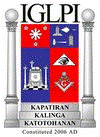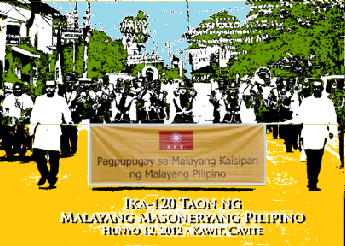The MW Independent Grand Lodge of Free and Accepted Masons of the Philippines

Founded 150 years after the first Masonic lodge, La Primera Luz Filipina under the Portuguese Gran Oriente Lusitano, was established in 1856 in Kawit, Cavite, and 100 years after the establishment in 1906 of the Gran Logia Regional de Filipinas by seven lodges of the Grande Oriente Español, the Independent Grand Lodge of Free and Accepted Masons of the Philippine Islands takes pride in having four century-old lodges. The oldest, Pilar Lodge in Imus, Cavite traces its roots as early as 1894 or two years after the first truly Filipino Lodge, Logia Nilad No 144 was established in Manila under the Grande Oriente Español. Pilar Lodge then called Logia Pilar No 203 was the lodge that initiated into Masonry, General Emilio Aguinaldo, president of the first Philippine Republic.
The second oldest is Cavite Lodge, a former all-American lodge established under the Grand Lodge of California in 1902 and chartered in 1903. This lodge was one of the three American lodges that organized the Grand Lodge of the Philippines in 1912. Bagong Buhay Lodge was founded in Cavite City in 1907, the first lodge to be established under the Gran Logia Regional (Regional Grand Lodge), of the Grande Oriente Español in the Philippines. One of its founders was Ladislao Diwa, who together with six other Filipino masons, founded the pro-revolution Katipunan in 1892. President Emilio Aguinaldo Memorial Lodge was originally Logia Magdalo, founded by General Emilio Aguinaldo in 1914 in Kawit, Cavite, also under the auspices of the Grande Oriente Español. Lodges Pilar, Bagong Buhay, Magdalo and 24 other lodges of the Regional Grand Lodge of the Philippines of the Grande Oriente Español were re-chartered and re-numbered when they affiliated with the Grand Lodge of the Philippines in 1917. Logia Magdalo was later called Ibarra Lodge No 31 but after Aguinaldo's death, it was renamed Emilio Aguinaldo Memorial Lodge. Cavite Lodge (No 350, Grand Lodge of California) was renumbered as Cavite Lodge No 2. These four lodges, along with three other regular lodges of the Grand Lodge of the Philippines, Bagong Ilaw Lodge (1925); La Naval (1984) and Mendez-Nunez (1997) in 2006, formed the Independent Grand Lodge of Free and Accepted Masons of the Philippine Islands. Pintong Bato Lodge in Bacoor, Cavite affiliated in 2007. Since then, six lodges have been added: Freedom Lodge No 10, Amity Lodge No 11, Barasoain Lodge No 12, Katatagan Lodge No 13, Bangued Lodge No 14 and A. Ramento Memorial No 15 in Binalonan, Pangasinan. Another lodge Ibalon, U.D. in Nabua, Camarines Sur) is under dispensation. |

The Constitution of the Independent Grand Lodge of Free and Accepted Masons of the Philippine Islands was ratified on November 25, 2006 during the First Annual Grand Assembly held at the Emilio Aguinaldo Memorial Lodge No 5, Kawit, Cavite. It defines the primary function of the Grand Lodge to preserve, protect, promote and propagate the tenets and ideals of Freemasonry and to enhance the welfare of the Fraternity and the Lodges in its jurisdiction.
Under the Constitution, the executive power of the Grand Lodge is vested in the Grand Master who presides over an Executive Council composed of all elected Grand Officers. The legislative power is vested in the Grand Assembly. In-between grand assemblies, it is exercised by the Legislative Council presided by the Deputy Grand Master. The Judicial power is vested in the Judicial Council presided by the Senior Grand Warden. All Grand Assemblies and official Grand Lodge functions are administered by the Junior Grand Warden. The Constitution also provides for the creation of a Council of Elders as an advisory and oversight body. It also provides for the formulation of implementing codes such as the Administrative Code, Judicial Code, Election and Appointments Code, and the Uniform Code of By-laws for Member Lodges. The importance of continuing Masonic Education is underscored by the constitutional mandate to establish an autonomous Center for Masonic Studies. |
